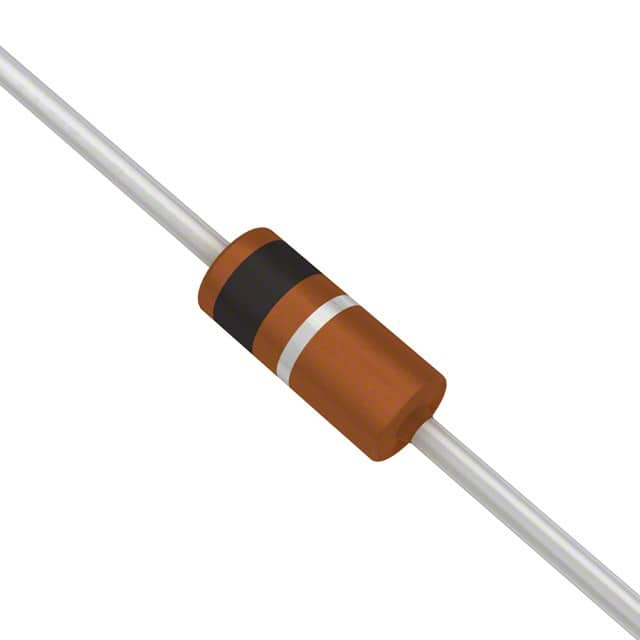Viz Specifikace pro podrobnosti o produktu.

1N5229C-TR
Introduction
The 1N5229C-TR is a diode belonging to the category of Zener diodes. This component is widely used in electronic circuits for voltage regulation and protection due to its unique characteristics. The following entry provides an overview of the basic information, specifications, pin configuration, functional features, advantages and disadvantages, working principles, application field plans, and alternative models of the 1N5229C-TR.
Basic Information Overview
- Category: Zener Diode
- Use: Voltage regulation and protection in electronic circuits
- Characteristics: Sharp breakdown voltage, low impedance, high reliability
- Package: DO-35
- Essence: Semiconductor device for precise voltage regulation
- Packaging/Quantity: Available in tape and reel packaging, quantity varies by manufacturer
Specifications
- Voltage Range: 3.3V to 200V
- Power Dissipation: 500mW
- Operating Temperature: -65°C to +200°C
- Zener Impedance: 5Ω to 100Ω
- Tolerance: ±5% to ±10%
Detailed Pin Configuration
The 1N5229C-TR has two pins, anode (A) and cathode (K), which are identified by the color band on the diode body. The anode is connected to the positive terminal, while the cathode is connected to the negative terminal in the circuit.
Functional Features
- Precise Voltage Regulation: Maintains a constant voltage across the load
- Overvoltage Protection: Prevents damage to sensitive components by diverting excess voltage
- Low Impedance: Allows for efficient current flow during regulation
Advantages and Disadvantages
Advantages
- Reliable voltage regulation
- Compact size
- Wide voltage range options
Disadvantages
- Limited power dissipation capability
- Sensitivity to temperature variations
Working Principles
The 1N5229C-TR operates based on the Zener effect, where it maintains a nearly constant voltage across its terminals when reverse-biased at or above its breakdown voltage. This allows it to regulate the voltage across a load connected in parallel with the diode.
Detailed Application Field Plans
The 1N5229C-TR finds extensive use in various applications, including: - Voltage regulators in power supplies - Overvoltage protection in electronic circuits - Signal clamping and limiting circuits - Voltage reference sources
Detailed and Complete Alternative Models
Several alternative models to the 1N5229C-TR include: - 1N5230B-TR - 1N5228A-TR - BZX84C3V3-7-F
These alternatives offer similar voltage regulation and protection capabilities, catering to different design requirements and preferences.
In conclusion, the 1N5229C-TR Zener diode serves as a crucial component in electronic circuits, providing reliable voltage regulation and overvoltage protection. Its unique characteristics and wide range of applications make it an essential part of modern electronics.
Word count: 443
Seznam 10 běžných otázek a odpovědí souvisejících s aplikací 1N5229C-TR v technických řešeních
What is the voltage rating of 1N5229C-TR?
- The voltage rating of 1N5229C-TR is 3.3V.
What is the maximum current that 1N5229C-TR can handle?
- The maximum current for 1N5229C-TR is typically around 500mA.
What is the package type of 1N5229C-TR?
- 1N5229C-TR comes in a DO-35 package.
What are the typical applications of 1N5229C-TR?
- 1N5229C-TR is commonly used in voltage regulation, overvoltage protection, and general purpose diode applications.
What is the reverse leakage current of 1N5229C-TR?
- The reverse leakage current is typically very low, in the range of microamps.
Can 1N5229C-TR be used in automotive applications?
- Yes, 1N5229C-TR can be used in automotive electronics where its voltage rating and current handling capabilities are suitable.
Is 1N5229C-TR suitable for high-frequency applications?
- While it can function at moderate frequencies, it may not be ideal for very high-frequency applications due to its inherent capacitance and response time.
What is the temperature range for 1N5229C-TR?
- 1N5229C-TR typically operates within a temperature range of -65°C to 200°C.
Does 1N5229C-TR require a heat sink for certain applications?
- In high-power or high-temperature applications, a heat sink may be necessary to ensure proper thermal management.
Are there any specific soldering guidelines for 1N5229C-TR?
- It is recommended to follow standard industry soldering practices, ensuring that the device is not subjected to excessive heat during soldering to prevent damage.

